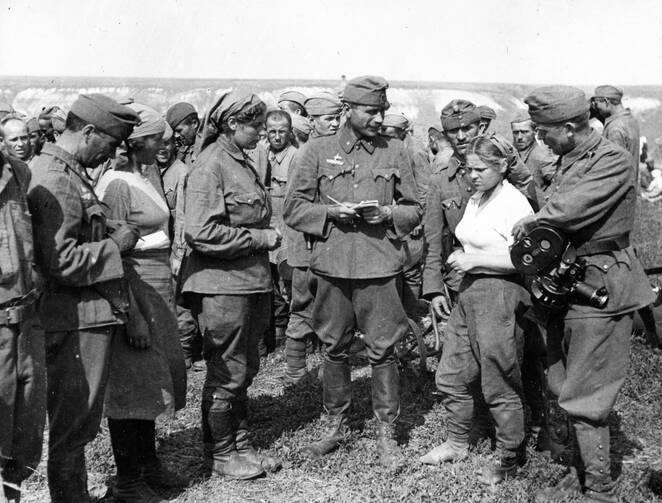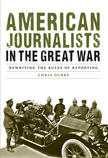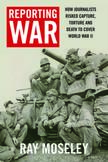Reporting on World War II: to hell and back, all for a good story
In the streets of Sarajevo, there is a marker commemorating the place and moment that abruptly turned the course of history. It brought the fall of kings, a civilizational estrangement from God, the rise of hideous secular religions and slaughter on a scale unmatched by all previous human history. In the summer of 1914, in that spot, a Serb anarchist murdered the archduke of Austria and his wife, unleashing a hell on earth that spanned two world wars.
For journalists, reporting from hell would be the greatest news story ever. But getting the story sometimes came at a price.
Two fresh titles now tell the tales of these tale-tellers: the journalist Chris Dubbs’s American Journalists in the Great War: Rewriting the Rules of Reporting and the foreign correspondent Ray Moseley’s Reporting War: How Foreign Correspondents Risked Capture, Torture and Death to Cover World War II.
Dubbs picks up just before the Great War, in the waning age of yellow journalism, in which reporters exaggerated or fabricated stories to boost circulation (a thing not entirely foreign to our moment).
War reporting had produced some of the yellowest journalism. But war reporting was also associated with high adventure and debonair figures like Richard Harding Davis. As Dubbs writes, Davis was famous for “the equipment and supplies that he took on military campaigns, which might include several pack animals and servants to manage the safari-like mountain of such luxury items as a folding bathtub and a hoard of food and fine wines.” Davis dressed like a military officer, complete with war campaign ribbons and a sidearm.
At the start of war, Davis made reporting history with his description of the German advance through Belgium: “And for three days and three nights through Brussels it roared and rumbled, a cataract of molten lead...like a river of steel...a monstrous engine.”
Davis also filled his reporting with interventionist propaganda, using the “desecration” of Rheims cathedral by the Germans as Exhibit A. As a result of this reporting by Davis and other reporters, Germany was cast as the antagonist.
While Davis was the most famous Great War correspondent, others were likewise remarkable. Dubbs tells of Robert Dunn, infamous for borrowing a Bavarian infantryman’s gun to take a couple of shots in the direction of the French lines. There was the photographer Donald Thompson, who set up his camera on hot battlefields and on the streets of the Russian revolution.
There was Stanley Washburn, a veteran reporter who became a propagandist and secret agent on behalf of the Russian czar. There was Granville Fortescue, an erstwhile Rough Rider who wrote from a learned military perspective. There was Floyd Gibbons, whose eye was shot out as he assisted a fallen officer in France. And then there was Herbert Bayard Swope, whose scrupulous objectivity and depth of reporting inside the German Empire won him a Pulitzer.
Dubbs explores the great stories of the war, including the Southerner Irvin Cobb’s account of the extraordinary heroism of two black soldiers from New York. Cobb concluded, “If ever proof were needed, which it is not, that the color of a man’s skin has nothing to do with the color of his soul, these twain then and there offered it in abundance.” Perhaps the most famous soldier story was George Pattullo’s piece on Sergeant York, a hard-praying Tennessean who used his backwoods marksmanship to take down two dozen attacking Germans.
The Great War had a tincture of tragic elegy.... World War II, by contrast, was thoroughly modern, disengaged from any romantic past.
When World War II broke out during the pontificate of Pope Pius XII, a new generation of reporters—some now armed with microphones—swarmed to cover it. Moseley’s Reporting War projects the drama through these reporters’ eyes, creating a unique history of World War II.
If Richard Harding Davis, with his taste for Victorian luxuries, embodied the reporting on World War I, then Ernie Pyle, with his gritty devotion to the common soldier, embodied World War II. Davis wrote floridly of World War I and went home safe. But Pyle wrote of World War II with a sense of personal foreboding; he saw it as an “unalleviated misfortune” to which he, after long years telling infantrymen’s stories, succumbed in an infantryman’s ditch on a Japanese island.
The Great War had a tincture of tragic elegy—the senseless immolation of a glittering 19th-century European civilization. World War II, by contrast, was thoroughly modern, disengaged from any romantic past. And Moseley explores the wretched disenchantment of those years relentlessly.
Pyle’s viewpoint brought to mind that of my grandfather, Major Nicholas Campbell, an Army doctor who tended to mangled soldiers through the North African and Italian campaigns. When asked, he said little about the war, and certainly never glorified it, but once murmured dolefully: “I thought it was never going to end.” As Pyle put it, war “isn’t something in a book or a picture, but friends of yours getting battered to pieces a few yards from you.”
In the long term, the war meant the rise and fall of many reporters.
For the reporters, WWII might mean drowning in a sunken vessel in the Mediterranean, being shot up in a roadside ambush in the Libyan desert, getting strafed by German planes, spending years in a prison camp, plunging to your death in a shot-down plane, enduring torture or pulling a dead gunner out of the way and climbing into his bubble to blow away an enemy aircraft. For Ernest Hemingway, it meant arming oneself for grandiose, embarrassing expeditions in the French countryside.
In the long term, the war meant the rise and fall of many reporters. Some became traitors and spies. Some cheated on their spouses. Some escaped into alcohol. Some got divorces. A few committed suicide.
Reading Dubbs and Moseley caused me to reflect on an interlude as a modern war correspondent in the former Yugoslavia in summer 1995. In some ways, the dangers had not changed. In one devastated village, the invaders had ripped the cupola off the village church and dragged it up an embankment. After inspecting it up close, I came down and learned it was a trap—the Bosnian Serbs had surrounded the cupola with mines. I just got lucky by realizing it before it was too late.
But the main story that summer was one I watched on television from the safety of an apartment in Zagreb. Cowardly U.N. Protection Forces were abandoning the town of Srebrenica in the face of a Serb advance, leaving the locals to defend the town with nothing but hunting rifles. I saw General Mladic load buses with men and boys, headed for what any clear-eyed person knew were mass graves. War reporting had changed. The siege of Srebrenica was broadcast live. But to what effect? No saviors came.
In telling the tale of reporters competing to get “the story,” Dubbs and Moseley cause one to ponder the worm that often burrows at the core of journalism: To what effect do reporters report? Is it a vain yearning to be known for getting the scoop? A wish to entertain and titillate an audience? A desire to bend public opinion to their views? Or is it a sincere and humble hope that they are doing the public a service? While Dubbs and Moseley never ask or answer these questions, every reporter should.
This article also appeared in print, under the headline “To hell and back, all for a good story,” in the Fall Literary Review 2017, issue.











